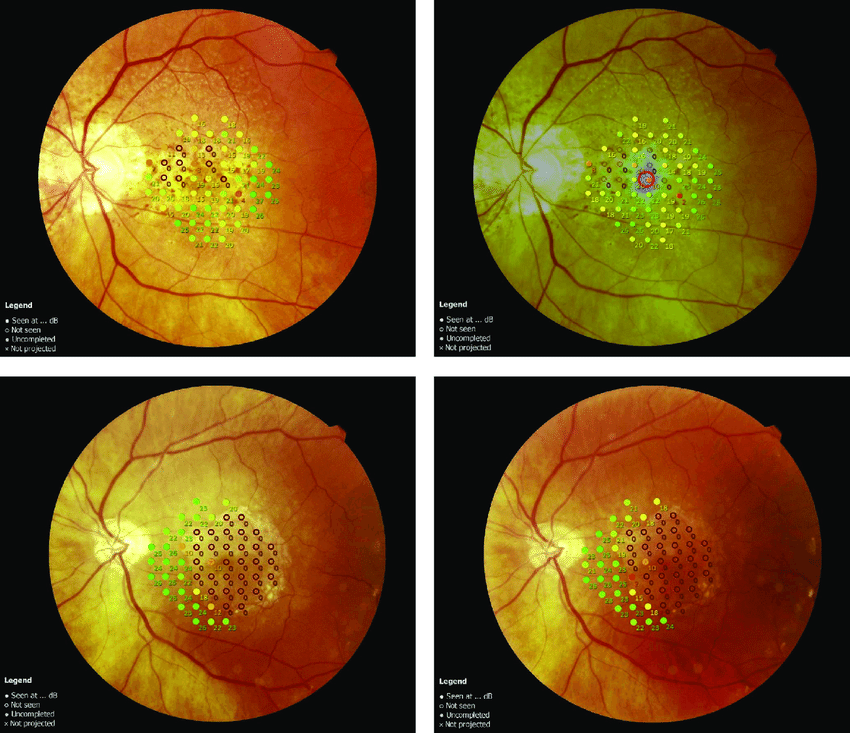 |
| If the area adjacent to absolute scotoma is destined to atrophy, the parameter of responding sensitivity may provide the best information on remaining macular response and visual function over time. Photo:Palkovits S, et al. Translational Vision Science & Technology February 2018, Vol.7, 17. Click image to enlarge. |
In a new study spanning one of the largest datasets collected of microperimetry (MP) in macular diseases, patients underwent a 96-week trial to determine what measures were best to assess deterioration. Patients 50 or older with bilateral geographic atrophy (GA) and with no previous or current evidence of neovascular age-related macular degeneration were included from two identically designed phase III clinical trials, Chroma and Spectri.
Participants were randomized 2:1:2:1 through the 96 weeks to receive intravitreal lampalizumab 10mg every four or six weeks or undergo sham procedures. New endpoints of perilesional sensitivity (average of points adjacent to absolute scotomatous points) and responding sensitivity (average of all nonscotomatous points; >0dB at baseline) were assessed using customized masks for each patient. These were then compared with the typical MP endpoints of mean macular sensitivity and the number of absolute scotomatous points.
Of the 277 participants, 197 (71.1%) had reliable MP results. Across the treatment groups, GA lesion area expanded by about 2mm2 per year and patients saw deterioration in all MP parameters. Macular sensitivity and absolute scotomatous points did not differ or worsen among treatment groups; however, perilesional and responding sensitivities did show more decline over time than mean macular sensitivity. At week 48, better correlation was seen with perilesional and responding sensitivities for change in GA lesion area than mean macular sensitivity, but correlation was the greatest with number of absolute scotomatous points.
The study authors believe the lower magnitude seen with mean macular sensitivity is likely due to using all tested points, which can weaken the mean. The novel sensitivities, however, exclude absolute scotomatous points identified initially, making them more sensitive than the mean macular sensitivity and showing higher dB change with less variability.
Based on these observations, the authors state that “the results of this study can be taken into consideration when planning the use of various MP testing patterns and when interpreting their outputs, including a standard grid for all patients, such as the one used in this clinical development program, as well as linear/cross or custom-tailored patterns.”
Correlation of absolute scotomatous points was the strongest endpoint with GA lesion area over time and change in MP endpoints. Previous studies also confirmed that with increased GA lesion area came increased absolute scotoma. The authors mention that this endpoint cannot, despite its strong correlation, detect subtle reductions in retinal sensitivity “and is therefore likely to be less sensitive in evaluating treatment effects than the perilesional and responding retinal sensitivity endpoints.”
The weaker correlation between GA lesion area and mean macular sensitivity is thought to be caused by the parameter lacking spatial information, blunted by including absolute scotomatous points, or due to high variability seen in macular sensitivity measurements not seen with GA lesion area.
Overall, the researchers summarized their findings for greater application: “Results from this study allow us to propose perilesional and responding retinal sensitivity as novel MP endpoints that can capture visual functional decline over time with greater sensitivity. These functional endpoints may serve as a foundation for future clinical trials evaluating GA progression using MP to better characterize both the natural history of the disease as well as early treatment response.”
Chang DS, Callaway NF, Steffen V, et al. Macular sensitivity endpoints in geographic atrophy: exploratory analysis of Chroma and Spectri clinical trials. Ophthalmol Sci. June 12, 2023. [Epub ahead of print]. |

